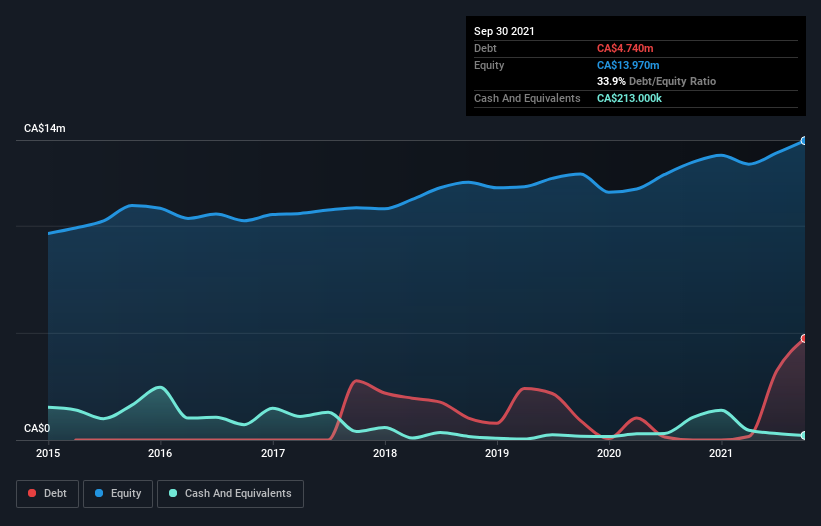David Iben put it well when he said, 'Volatility is not a risk we care about. What we care about is avoiding the permanent loss of capital.' So it might be obvious that you need to consider debt, when you think about how risky any given stock is, because too much debt can sink a company. As with many other companies Circa Enterprises Inc. (CVE:CTO) makes use of debt. But should shareholders be worried about its use of debt?
When Is Debt Dangerous?
Generally speaking, debt only becomes a real problem when a company can't easily pay it off, either by raising capital or with its own cash flow. In the worst case scenario, a company can go bankrupt if it cannot pay its creditors. However, a more usual (but still expensive) situation is where a company must dilute shareholders at a cheap share price simply to get debt under control. Having said that, the most common situation is where a company manages its debt reasonably well - and to its own advantage. The first thing to do when considering how much debt a business uses is to look at its cash and debt together.
View our latest analysis for Circa Enterprises
How Much Debt Does Circa Enterprises Carry?
You can click the graphic below for the historical numbers, but it shows that as of September 2021 Circa Enterprises had CA$4.74m of debt, an increase on none, over one year. However, it does have CA$213.0k in cash offsetting this, leading to net debt of about CA$4.53m.

A Look At Circa Enterprises' Liabilities
Zooming in on the latest balance sheet data, we can see that Circa Enterprises had liabilities of CA$9.77m due within 12 months and liabilities of CA$4.41m due beyond that. Offsetting these obligations, it had cash of CA$213.0k as well as receivables valued at CA$6.87m due within 12 months. So its liabilities total CA$7.10m more than the combination of its cash and short-term receivables.
Circa Enterprises has a market capitalization of CA$14.6m, so it could very likely raise cash to ameliorate its balance sheet, if the need arose. But it's clear that we should definitely closely examine whether it can manage its debt without dilution.
In order to size up a company's debt relative to its earnings, we calculate its net debt divided by its earnings before interest, tax, depreciation, and amortization (EBITDA) and its earnings before interest and tax (EBIT) divided by its interest expense (its interest cover). Thus we consider debt relative to earnings both with and without depreciation and amortization expenses.
Circa Enterprises's net debt to EBITDA ratio of about 1.7 suggests only moderate use of debt. And its strong interest cover of 11.1 times, makes us even more comfortable. On top of that, Circa Enterprises grew its EBIT by 87% over the last twelve months, and that growth will make it easier to handle its debt. The balance sheet is clearly the area to focus on when you are analysing debt. But it is Circa Enterprises's earnings that will influence how the balance sheet holds up in the future. So when considering debt, it's definitely worth looking at the earnings trend. Click here for an interactive snapshot.
Finally, a company can only pay off debt with cold hard cash, not accounting profits. So we always check how much of that EBIT is translated into free cash flow. In the last three years, Circa Enterprises's free cash flow amounted to 27% of its EBIT, less than we'd expect. That weak cash conversion makes it more difficult to handle indebtedness.
Our View
Circa Enterprises's EBIT growth rate was a real positive on this analysis, as was its interest cover. On the other hand, its conversion of EBIT to free cash flow makes us a little less comfortable about its debt. Considering this range of data points, we think Circa Enterprises is in a good position to manage its debt levels. But a word of caution: we think debt levels are high enough to justify ongoing monitoring. When analysing debt levels, the balance sheet is the obvious place to start. But ultimately, every company can contain risks that exist outside of the balance sheet. For example, we've discovered 5 warning signs for Circa Enterprises (2 make us uncomfortable!) that you should be aware of before investing here.
If you're interested in investing in businesses that can grow profits without the burden of debt, then check out this free list of growing businesses that have net cash on the balance sheet.
New: AI Stock Screener & Alerts
Our new AI Stock Screener scans the market every day to uncover opportunities.
• Dividend Powerhouses (3%+ Yield)
• Undervalued Small Caps with Insider Buying
• High growth Tech and AI Companies
Or build your own from over 50 metrics.
Have feedback on this article? Concerned about the content? Get in touch with us directly. Alternatively, email editorial-team (at) simplywallst.com.
This article by Simply Wall St is general in nature. We provide commentary based on historical data and analyst forecasts only using an unbiased methodology and our articles are not intended to be financial advice. It does not constitute a recommendation to buy or sell any stock, and does not take account of your objectives, or your financial situation. We aim to bring you long-term focused analysis driven by fundamental data. Note that our analysis may not factor in the latest price-sensitive company announcements or qualitative material. Simply Wall St has no position in any stocks mentioned.
About TSXV:CTO
Circa Enterprises
Circa Enterprises Inc. manufactures and supplies telecommunications and electrical products in the United States, Canada, and internationally.
Flawless balance sheet and fair value.
Market Insights
Community Narratives



